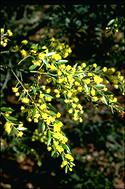Growing Friends 2017 Spring Plant Sale
You are here
The Growing Friends spring sale is scheduled for Saturday 11 November. Dr Suzi Bond will be available to sign copies of her book Field Guide of the Butterflies of the ACT and discuss plants that attract butterflies to the garden.
Dr Suzi Bond is a Visiting Fellow at the ANU where she researches the butterflies found in the ACT. Her research is driven by a fascination for our local butterfly fauna and a desire to better understand their populations and ecology. Her beautiful book includes detailed notes and photographs of the wide range of butterflies found across the Australian Capital Territory with contributions from Steve Holliday and John Stein.
Plants in the spring sale that Suzi has identified as being used as larval food plants by local butterflies are: Polyscias sambucifolia – Dark Pencil-blue (Candalides consimilis); and Pomaderrris ericephala – Yellow Jewel (Hypochrysops byzos). Other plants that will provide nectar-rich flowers that are accessible to butterflies: Brachyscome, Callistemon, Grevillea, Kunzea, Leptospermum, Melaleuca, Pimelea and Senecio, are also for sale.
Copies of Suzi’s book are available at the Botanical Bookshop in the ANBG Visitor Centre.
A list of the plants available for sale is available
More generally, Growing Friends will be offering a range of Correas and Croweas, Boronias, and the following feature plants:
Acacia howittii

M. Fagg - ANBG
A compact form but still a large shrub or small tree that would be suited to bigger gardens. It can take up to 30 years to reach full height of 3-5m x 2-3m. It makes an excellent screening plant and responds well to hard pruning. Specimens in the Australian National Botanic Gardens, restricted to a height of 1 m, thickened up so rapidly that they formed an ideal hedge plant that can withstand hard pruning to shape. In the Gardens the species has been used as a screen plant and one stand of seven plants (since removed) used for screening an amenities block on the Eucalyptus Lawn was planted at 2m spacing and after 10 years formed a dense wall 3 m high. This height is maintained by cutting the tops back 2 m each year. Some protection for small plants in newly established gardens is recommended. A. howittii has been recorded to escape cultivation and occur as a weed of bushland in south-eastern Australia and consideration should therefore be given to its potential for invasiveness.
Epacris longifolia

M Fagg - ANBG
Epacris longiflolia is common in moist sandstone gullies around the central coast of New South Wales and is also found further north in that state and around the NSW/Queensland border. It is typically a fairly straggly shrub comprising several long, arching branches and is usually less than a metre in height. The flowers are narrow and tubular and occur along the branches. They contain nectar and are frequented by honey-eating birds. The typical colour is red with a white tip but some variations are in cultivation such as a fully white form. In nature, the plant almost always has some flowers present but cultivated plants seem to have a peak during
summer-autumn. It should be given a well-drained position in semi shade but not allowed to dry out. It is also a very attractive plant for a container where the arching branches are seen to best advantage. The plant responds to pruning but this produces a more compact plant at the expense of the natural arching habit
Wahlenbergia gloriosa

M. Fagg - Near Cabramurra, Kosciuszko National Park, NSW
Wahlenbergia gloriosa, commonly known as the Royal Bluebell, belongs to the bluebell family Campanulaceae. It is naturally restricted to the alpine and sub-alpine areas of the Australian Capital Territory (ACT), south-eastern New South Wales and eastern Victoria. It is a frost hardy ground cover and grows best in a light, enriched soil in either sunny or semi-shaded positions in cool regions. As the plant is very shallow rooted, the soil should be kept moist but not water logged and well-drained soils are essential. The soil can be enriched by the use of well-rotted compost or other organic matter, such as humus. The organic material added to the soil also helps to lighten it, thus enabling the plant to sucker and spread, sometimes over large distances, but it does not have the potential to become a problem in the garden. Though it makes great ground cover it also grows very well in shallow pots and hanging baskets. The flowering period usually extends from October through to March. The flowers are short-lived when cut but potted specimens in flower are suitable for indoor decoration in brightly lit positions.

